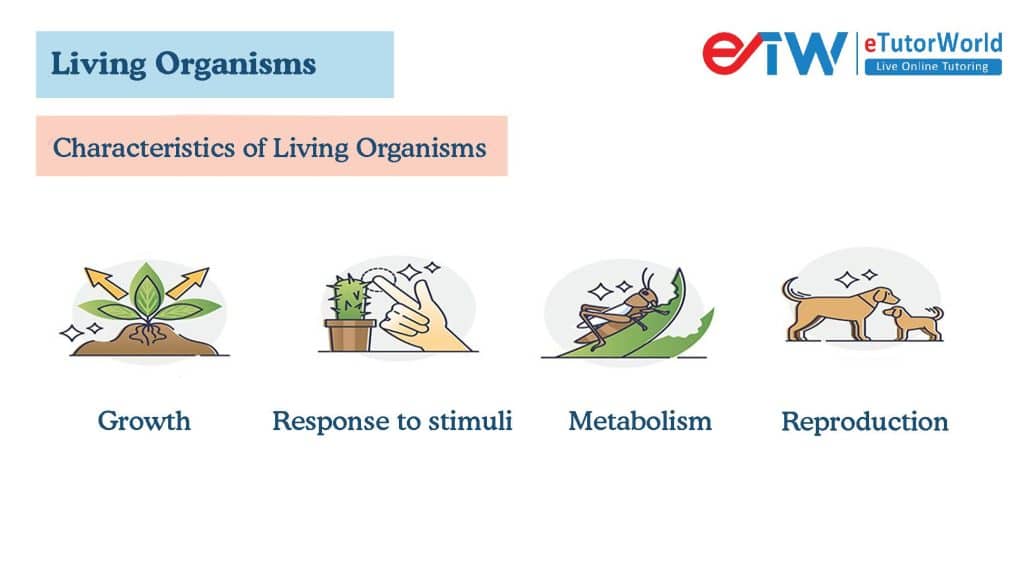Characteristics of Living Organism
Grade 7 Science Worksheets
Living organisms are defined by several characteristics that distinguish them from non-living matter.
Table of Contents:
- What is Biodiversity
- Different Types of Biodiversity
- Importance of Biodiversity
- Biodiversity and Humans
- FAQs
Characteristics of Living Organism - Grade 7 Science Worksheet PDF
This is a free printable / downloadable PDF worksheet with practice problems and answers. You can also work on it online.
|
|
Untimed |
|
Sign up with your email ID to access this free worksheet.
"We really love eTutorWorld!"
"We really love etutorworld!. Anand S and Pooja are excellent math teachers and are quick to respond with requests to tutor on any math topic!" - Kieran Y (via TrustSpot.io)
"My daughter gets distracted easily"
"My daughter gets distracted very easily and Ms. Medini and other teachers were patient with her and redirected her back to the courses.
With the help of Etutorworld, my daughter has been now selected in the Gifted and Talented Program for the school district"
- Nivea Sharma (via TrustSpot.io)
Living organisms are defined by several characteristics that distinguish them from non-living matter. These characteristics are:
Cellular organization: All living organisms are made up of one or more cells, which are the basic unit of life. Cells are highly organized structures with specific functions. For example, bacteria are unicellular organisms, while humans are multicellular organisms made up of trillions of cells.
Metabolism: Living organisms carry out various chemical reactions to obtain and utilize energy from their environment. This process is known as metabolism. For example, plants use photosynthesis to convert sunlight into energy, while animals consume food and oxygen to produce energy.
Growth and development: Living organisms have the ability to grow and develop. This means that they can increase in size and complexity over time. For example, a tree starts as a small seedling and grows into a mature tree over many years.
Response to stimuli: Living organisms can respond to changes in their environment, such as changes in temperature, light, or food availability. This ability to respond to stimuli is known as irritability or responsiveness. For example, a plant will grow towards a source of light, while a dog will wag its tail when it is happy.
Reproduction: Living organisms have the ability to reproduce and pass on their genetic information to their offspring. This ensures the continuation of the species. For example, bacteria can reproduce asexually by dividing into two identical cells, while humans reproduce sexually, with two parents contributing genetic material to their offspring.
Overall, these characteristics work together to define the unique properties of living organisms and differentiate them from non-living matter.
Differences between living & non-living organisms
Living organisms and non-living matter differ in several key ways:
Cellular Organization: Living organisms are made up of one or more cells, which are highly organized structures with specific functions. Non-living matter, on the other hand, does not have a defined structure or organization.
Metabolism: Living organisms carry out various chemical reactions to obtain and utilize energy from their environment. This process is known as metabolism, while non-living matter does not have a metabolism.
Growth and Development: Living organisms have the ability to grow and develop. This means that they can increase in size and complexity over time. Non-living matter does not have the ability to grow or develop.
Response to Stimuli: Living organisms can respond to changes in their environment, such as changes in temperature, light, or food availability. This ability to respond to stimuli is known as irritability or responsiveness. Non-living matter does not have the ability to respond to stimuli.
Reproduction: Living organisms have the ability to reproduce and pass on their genetic information to their offspring. This ensures the continuation of the species. Non-living matter does not have the ability to reproduce.
Homeostasis: Living organisms maintain a stable internal environment, which is known as homeostasis. Non-living matter does not have a mechanism for maintaining a stable internal environment.Homeostasis is the ability of living organisms to maintain internal stability and balance despite external changes. Organisms regulate their internal conditions, such as body temperature, pH levels, and nutrient concentrations, to ensure optimal functioning. Homeostasis is achieved through various feedback mechanisms and is crucial for the survival and proper functioning of living organisms.
Evolution: Living organisms evolve over time through the process of natural selection. Non-living matter does not evolve.
Ecological Interactions: Living organisms interact with each other and their environment in complex ways. These interactions include predator-prey relationships, symbiosis, competition for resources, and the flow of energy and matter within ecosystems. Understanding the ecological interactions among living organisms provides insights into the interconnectedness and dynamics of ecosystems.
Overall, these differences between living organisms and non-living matter illustrate the unique properties of life and help define the boundaries between living and non-living systems.

Types of living organisms
There are many types of living organisms, each of which has unique characteristics and plays a specific role in the ecosystem. Some of the major types of living organisms include:
Bacteria: Bacteria are single-celled organisms that are found in almost every environment on Earth. They play important roles in the cycling of nutrients and are used in various industries, such as food production and biotechnology. Examples include Escherichia coli, Streptococcus pneumoniae, and Lactobacillus acidophilus.
Archaea: Archaea are single-celled organisms that are similar to bacteria but have distinct genetic and biochemical features. They are found in extreme environments such as hot springs and deep-sea hydrothermal vents. Examples include Methanobrevibacter smithii and Thermoplasma acidophilum.
Protists: Protists are a diverse group of eukaryotic organisms that are often unicellular, but can also be multicellular. They can be found in almost any aquatic or moist environment and can have a variety of nutritional modes. Examples include Amoeba proteus, Paramecium caudatum, and Plasmodium falciparum.
Fungi: Fungi are eukaryotic organisms that include yeasts, molds, and mushrooms. They play important roles in decomposition and nutrient cycling and are also used in the production of food and medicine. Examples include Saccharomyces cerevisiae, Penicillium chrysogenum, and Agaricus bisporus.
Plants: Plants are multicellular organisms that are capable of photosynthesis, in which they convert light energy into chemical energy. They provide food, shelter, and oxygen for many other organisms and are a major component of the Earth’s ecosystem. Examples include Arabidopsis thaliana, Zea mays, and Pinus ponderosa.
Animals: Animals are multicellular organisms that are capable of movement and heterotrophic nutrition, in which they consume other organisms for energy. They play important roles in pollination, seed dispersal, and nutrient cycling. Examples include Homo sapiens, Mus musculus, and Canis lupus.
Overall, the diversity of living organisms is vast and complex, and each type has unique characteristics and plays a specific role in the ecosystem.

“There have been times when we booked them last minute, but the teachers have been extremely well-prepared and the help desk at etutorworld is very prompt.
Our kid is doing much better with a higher score.”
7th Grade Tutoring
eTutorWorld offers Personalized Online Tutoring for Math, Science, English, and Standardised Tests.
Our Tutoring Packs start at just under $21 per hour, and come with a moneyback guarantee.
Schedule a FREE Trial Session, and experience quality tutoring for yourself. (No credit card required.)
Cellular levels of living organisms
Living organisms can be organized into different cellular levels, which vary in complexity and specialization. The major cellular levels of living organisms are:
Prokaryotic Cells: Prokaryotic cells are simple, single-celled organisms that lack a nucleus and membrane-bound organelles. They are typically small in size and have a relatively simple structure. Examples of prokaryotic organisms include bacteria and archaea.
Eukaryotic Cells: Eukaryotic cells are more complex than prokaryotic cells and have a nucleus and membrane-bound organelles. They can be unicellular or multicellular and have a variety of functions and structures. Examples of eukaryotic organisms include protists, fungi, plants, and animals.
Tissues: Tissues are groups of specialized cells that work together to perform a specific function. In multicellular organisms, tissues are organized into organs and organ systems. Examples of tissues include muscle tissue, nervous tissue, and epithelial tissue.
Organs: Organs are structures that are made up of multiple tissues and perform specific functions within the body. Examples of organs include the heart, lungs, and liver.
Organ Systems: Organ systems are groups of organs that work together to perform a specific function. Examples of organ systems include the digestive system, respiratory system, and nervous system.
Organisms: Organisms are complete living beings that are composed of cells and have a defined structure and function. Examples of organisms include bacteria, plants, animals, and humans.
Overall, the cellular levels of living organisms illustrate the hierarchy of complexity and specialization in the organization of living systems.
Do You Stack Up Against the Best?
If you have 30 minutes, try our free diagnostics test and assess your skills.
FAQS
What is the difference between prokaryotic and eukaryotic cells?
Prokaryotic cells are simple, single-celled organisms that lack a nucleus and membrane-bound organelles. Eukaryotic cells, on the other hand, are more complex and have a nucleus and membrane-bound organelles.
What are tissues?
Tissues are groups of specialized cells that work together to perform a specific function, such as muscle tissue, nervous tissue, and epithelial tissue.
What are organs?
Organs are structures that are made up of multiple tissues and perform specific functions within the body, such as the heart, lungs, and liver.
What are organ systems?
Organ systems are groups of organs that work together to perform a specific function, such as the digestive system, respiratory system, and nervous system.
How do cellular levels relate to the organization of living organisms?
Cellular levels in living organisms illustrate the hierarchy of complexity and specialization in the organization of living systems, from simple prokaryotic cells to complex multicellular organisms with specialized tissues, organs, and organ systems.
Are all living organisms made up of cells?
Yes, all living organisms are made up of one or more cells, which are the basic unit of life.
What are some examples of eukaryotic organisms?
Examples of eukaryotic organisms include protists, fungi, plants, and animals, which are all composed of eukaryotic cells.

Kathleen Currence is one of the founders of eTutorWorld. Previously a middle school principal in Kansas City School District, she has an MA in Education from the University of Dayton, Ohio. She is a prolific writer, and likes to explain Science topics in student-friendly language. LinkedIn Profile
Affordable Tutoring Now Starts at Just $22.49
eTutorWorld offers affordable one-on-one live tutoring over the web for Grades K-12. We are also a leading provider of Test Prep help for Standardized Tests (SCAT, CogAT, MAP, SSAT, SAT, ACT, ISEE, and AP).
What makes eTutorWorld stand apart are: flexibility in lesson scheduling, quality of hand-picked tutors, assignment of tutors based on academic counseling and diagnostic tests of each student, and our 100% money-back guarantee.
Whether you have never tried personalized online tutoring before or are looking for better tutors and flexibility at an affordable price point, schedule a FREE TRIAL Session with us today.
*There is no purchase obligation or credit card requirement
Grade 7 Science Worksheets
- Elements and Compounds
- Solar Energy
- Photosynthesis
- Electricity and Magnetism
- Law of conservation of energy
- Periodic table
- Properties of Matter
- Waves
- Energy Resources
- Weather and Climate
- Immune, Circulatory and Digestive Systems
- Organs in Multi-cellular Organism
- Sedimentary, Igneous, and Metamorphic Rocks
- Structure of the Earth
- Law of Conservation of Mass
- Physical and Chemical Changes
- Scientific Method
- Human Digestive System
- Environmental Science
- Renewable and Non-renewable energy Resources
- Characteristics of Living Organisms
- Life Science
- Earth and Space Science
- Solar Eclipse
- Heat Technology
- Newton’s Laws of Motions
- Physical Science
- Tools, Measurement and SI Units
- Earth Atmosphere
- Interactions of Living things
- The Earth Ecosystem
- Organelles in Plant and Animal cells
- Layers of the Earth
- Cycles in Nature
Grade 7 Math Worksheets
- Fractions
- Linear equations word problems
- Statistics
- Properties of Parallel Line
- Finding slope from an equation
- Identifying Quadrilaterals
- Percent Change
- Properties of addition and multiplication
- Pythagorean Theorem
- Solving two step inequalities
- Symmetry
- Fractions to Decimals (New)
- Whole Number Exponents with Integer Bases (New)
- Adding and Subtracting Fractions (New)
- Integer Addition and Subtraction (New)
- Dividing Mixed Numbers (New)
- Basics of Coordinate Geometry (New)
IN THE NEWS

Our mission is to provide high quality online tutoring services, using state of the art Internet technology, to school students worldwide.
Online test prep and practice
SCAT
SSAT
ISEE
PSAT
SAT
ACT
AP Exam
Science Tutoring
Physics Tutoring
Chemistry Tutoring
Biology Tutoring
Math Tutoring
Pre-Algebra Tutoring
Algebra Tutoring
Pre Calculus Tutoring
Calculus Tutoring
Geometry Tutoring
Trigonometry Tutoring
Statistics Tutoring
Quick links
Free Worksheets
Fact sheet
Sales Partner Opportunities
Parents
Passive Fundraising
Virtual Fundraising
Our Expert Tutors
Safe and Secure Tutoring
Interactive Online Tutoring
After School Tutoring
Elementary School Tutoring
Middle School Tutoring
High School Tutoring
Home Work Help
Math Tutors New York City
Press
©2022 eTutorWorld Terms of use Privacy Policy Site by Little Red Bird
©2022 eTutorWorld
Terms of use
Privacy Policy
Site by Little Red Bird










